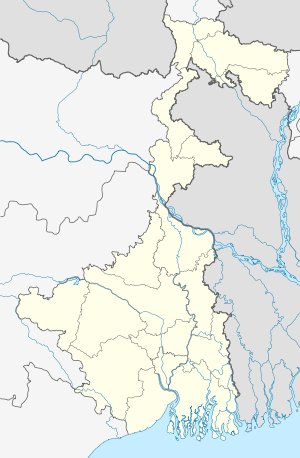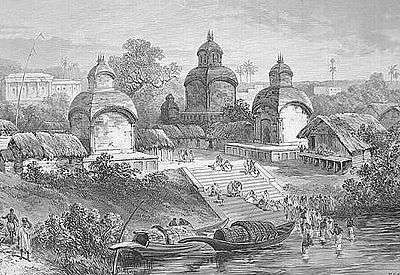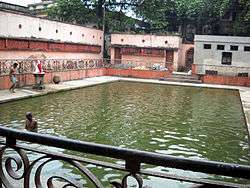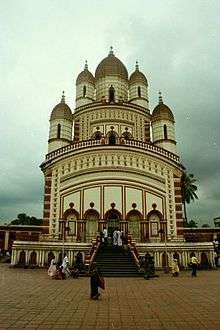Kalighat Kali Temple
| Kalighat Kali Temple | |
|---|---|
|
View of the Kalighat Temple | |
 Kalighat Kali Temple | |
| Name | |
| Devanagari | कालीघाट काली मंदिर |
| Sanskrit transliteration | कालीघाट शक्तिपीठम |
| Bengali | কালীঘাট কালী মন্দির |
| Geography | |
| Coordinates | 22°31′12″N 88°20′31″E / 22.52000°N 88.34194°ECoordinates: 22°31′12″N 88°20′31″E / 22.52000°N 88.34194°E |
| Country | India |
| State | West Bengal |
| Location | On the bank of the defunct Adi Ganga river, Calcutta |
| Culture | |
| Primary deity | Kali |
| Architecture | |
| Architectural styles | Bengal |
| History and governance | |
| Date built | 1809 |
| Creator | Santosh "Sabarna" Roy Chowdhury |
Kalighat Kali Temple (Bengali: কালীঘাট মন্দির) is a Hindu temple in West Bengal, India dedicated to the Hindu goddess Kali.[1] It is one of the 51 Shakti Peethas.
Kalighat was a Ghat (landing stage) sacred to Kali on the old course of the Hooghly river (Bhāgirathi) in the city of Calcutta. The name Calcutta is said to have been derived from the word Kalighat. The river over a period of time has moved away from the temple. The temple is now on the banks of a small canal called Adi Ganga which connects to the Hoogly. The Adi Ganga was the original course of the river Hoogly. Hence the name Adi (original) Ganga.
Worship
The temple is visited by pilgrims from all over India.
Legend
Kalighat is regarded as one of the 51 Shakti Peethas of India, where the various parts of Sati's body are said to have fallen, in the course of Shiva's Rudra Tandava. Kalighat represents the site where the toes of the right foot of Dakshayani or Sati fell. Legend has it that in January 1570, Padmabati Debi, wife of Jiya Gangopadhyaya of the Sabarna Roy Choudhury family saw a luminant ray of light coming from the Kali Kunda, and upon investigating its source came upon a piece of stone carved in the form of a human foot.[2] This divine occurring led to the birth of Laksmikanta Roy Choudhury later in October 1570[3]
Kalighat is also associated with the worship offered to Kali by a Dasanami Monk by name Chowranga Giri, and the Chowringee area of Calcutta is said to have been named after him.
History

The Kalighat temple in its present form is only about 200 years old, although it has been referred to in Mansar Bhasan composed in the 15th century, and in Kavi Kankan Chandi of the 17th century. Mention of the Kali temple is also found in Lalmohon Bidyanidhis's 'Sambanda Nirnoy".[4] Only two types of coins of Chandragupta II, who incorporated Vanga in the Gupta Empire, are known from Bengal. His Archer type coins, which became the most popular type of coinage with the Gupta rulers after Kumaragupta I, have been found in Kalighat. This is evidence of the antiquity of the place.
The original temple was a small hut. The present temple was erected by Santosh Roy Choudhury of Sabarna Roy Choudhury family of Barisha.[5] After the death of Sontosh Roy Choudhury in 1799, the temple was completed by his grandson Rajiblochon Roy Choudhury in 1809. Sabarna Roy Choudhury family is the original owner of this temple.[6] The Roy Choudhury family offered 595 bighas of land to the Temple deity as "Debutter" so that worship and service could be continued smoothly.[7] Halder family of Kalighat were appointed as "Purahitas" of the temple by the Sabarna Roy Choudhury family.[8][9] In the 1960s a committee was formed by the Supreme Court for the administrative management of the temple with representation from the Government.[10]
The image of Kali
The image of Kali in this temple is unique. It does not follow the pattern of other Kali images in Bengal. The present idol of touchstone was created by two saints - Atmaram Brahmachari and Brahmananda Giri based on the idol of Mata Bhubaneshwari,[11] the Kula Devi of the Sabarna Roy Choudhury family. Presently, the three huge eyes, long protruding tongue made of gold and four hands, which all are made of gold too. Two of these hands holding a scimitar and a severed head of the asura king 'Shumbha'. The scimitar signifies Divine Knowledge and the asura (or, human) head signifies human Ego which must be slain by Divine Knowledge in order to attain Moksha. The other two hands are in the abhaya and varada mudras or blessings, which means her initiated devotees (or anyone worshiping her with a true heart) will be saved as she will guide them here and hereafter.
Temple details
Sosthi Tala

This is a rectangular altar about three feet high bearing a small cactus plant. Beneath the tree, on an altar three stones are placed side by side - left to right representing the goddesses Shashthi (Sosthi), Sitala and Mangal Chandi. This sacred spot is known as Sosthi Tala or Monosha Tala. This altar was constructed by Gobinda Das Mondal in 1880. The place of the altar is the Samadhi of Brahmananda Giri. Here all the priests are female. No daily worship or offering of Bhog (food offering) is done here. The goddesses here are considered as part of Kali.
Natmondir
A large rectangular covered platform called Natmondir has been erected adjacent to the main temple, from where the face of the image can be seen. This was originally built by Zamindar Kasinath Roy in 1835. It has been subsequently renovated often.
Jor-bangla

The spacious varandah of the main temple Facing the image is known as Jor Bangla. Rituals occurring inside the sanctum sanctorum are visible from the Natmondir through the Jor-bangla.
Harkath Tala
This is the spot adjacent to the Natmondir, southwards meant for Bali (sacrifice). There are two Sacrificial altars for animal sacrifices side by side. These are known as Hari- Kath.
Radha-Krishna Temple
This temple is known as Shamo-ray temple and is situated inside the temple at the west side of the main temple. In 1723, a settlement officer of Mushirabad district first erected a separate temple for Radha-Krishna. In 1843 a Zamindar called Udoy Narayan Mondal erected the present temple in the same spot. The Dolmancho was founded in 1858 by Madan Koley of Saha Nagar. There is a separate kitchen for preparation of vegetarian Bhog (food offering) for Radha-Krishna.
Kundupukur

This is the sacred tank situated in the south-east of the temple outside the boundary walls. Present area of the tank is approximately 10 cottahs. In the past it was bigger and called 'Kaku-Kunda'. In 16th century 'Sati-Ango' ( the right toe of Sati) was discovered from this tank. This tank is well known for its power to bestow the boon of a child. The water from this tank is regarded as sacred as that of the Ganges. Efforts at draining the water from the tank for cleaning has failed in the past showing the possibility of a subterranean with Adi Ganga.
Associated Temples
Nakhuleshwar Mahadev Temple

This Shiva temple is dedicated to the consort of Maa Kali. It is situated in Haldar Para lane on the opposite side of the temple behind the police station. This temple is also very old and mentioned in the history.
The four Shiva temples inside the temple were constructed by different shebait families who retain control over them.
See also
Notes
- ↑ Balakrishnan, S (May 9, 2003). "Kali Mandir of Kolkata". The Hindu. Retrieved 2009-11-10.
- ↑ https://www.facebook.com/Mahatirthasabarnakalighat/
- ↑ Bangiya Sabarna Katha Kalishetra Kalikatah by Bhabani Roy Choudhury, Manna Publication. ISBN 81-87648-36-8
- ↑ Bangiya Sabarna Katha Kalishetra Kalikatah by Bhabani Roy Choudhury, Manna Publication. ISBN 81-87648-36-8
- ↑ http://www.westbengaltourism.gov.in/web/guest/kalighat
- ↑ http://www.sabarna.faithweb.com/custom4.html
- ↑ Bangiya Sabarna Katha Kalishetra Kalikatah by Bhabani Roy Choudhury, Manna Publication. ISBN 81-87648-36-8
- ↑ Bangiya Sabarna Katha Kalishetra Kalikatah by Bhabani Roy Choudhury, Manna Publication ISBN 81-87648-36-8
- ↑ https://www.facebook.com/Mahatirthasabarnakalighat/
- ↑ Bangiya Sabarna Katha Kalishetra Kalikatah by Bhabani Roy Choudhury, Manna Publication. ISBN 81-87648-36-8
- ↑ http://kamdev.faithweb.com/whats_new_1.html
References
- McDermott, Rachel Fell and Kripal, Jeffrey. J (Editors), Encountering Kali, Motilal Banarsidass Publishers Pvt. Ltd, Delhi, India, 2005. (ISBN 81-208-2041-X)
External links
Kolkata Bus Route Guide Kalighat Temple - Kalighat Kolkata
| Wikimedia Commons has media related to Kalighat Kali Temple. |


